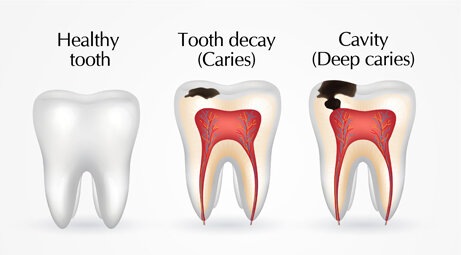Tooth decay or cavity is the breakdown of a tooth's enamel, a hard outer surface present on a tooth. Tooth decay could lead to cavities, which means it could lead to holes in the teeth. This thing gets serious when your child gets cavities as it questions your care. It could be dreading news for you. Please don't blame yourself as it is not your fault at all.
Tooth decay is caused by bacteria that are formed when food containing carbohydrates is left on the teeth. It includes food items such as raisins, candy, milk, soda, fruit juices, cereals, and bread. Bacteria in your mouth convert leftover food residues inside your mouth into acid. The combination of food, bacteria, saliva, and acid forms a substance known as plague. Plaque sticks to the teeth, and with time acids forming inside your mouth will eat away the tooth enamel, resulting in cavities in your child's tooth.
To get out of this problem and save the tooth from damage, you must consult pediatric dentistry McKinney. Find a reputable dentist and let him/her see the tooth to find your child's decaying tooth's exact situation.
What Are The Conditions That May Put Your Child At Risk Of Tooth Decay?
Though bacteria are present in every child’s mouth, it would not be wrong to say that every child is at risk for tooth decay. But the below conditions may put your child at high risk for it:
High levels of the bacteria that result in cavities
High sugar and starch diet
Limited or no fluoride water supply
Poor oral hygiene
Less saliva flow than normal
What Are The Symptoms of Cavities in Children?
When a tooth develops decay and cavities, symptoms may vary from one child to the other. Here are some common ways:
You may witness white spots on the affected areas. These spots mean that the enamel of your child's tooth has started to break down. This may cause sensitivity in the teeth.
An early cavity may seem to be on the tooth. It will appear light brown in color.
With time, the cavity becomes deeper and turns a darker shade of brown or even black.
As already mentioned, the symptoms of tooth decay may vary from one child to another. Generally, cavities don't always cause symptoms. When you take your child to the dentist, he/she finds it. But if in case you child feels:
Pain in the area around the tooth
Experience sensitivity to certain food items such as hot or cold drinks, sweets, and others
Both situations confirm that your child has a cavity that needs proper treatment.
How To Diagnose Tooth Decay In A Child?
A specialist of pediatric dentistry McKinney can diagnose your child's tooth decay based on:
Understanding the complete history of your child
Proper examination of your child's mouth
Dental X-rays
How To Treat Tooth Decay In A Child?
Tooth decay treatment in children entirely depends on your child's age, symptoms, and general health. It also depends on the severity of the child's dental conditions.
In most cases, treatment necessitates removing the decayed part of the tooth, which is later replaced with a filling. Fillings are materials placed in the tooth to repair damage caused by tooth decay. These fillings are known as restorations. There are different types of fillings:
Direct restorations: In this type, the filling is directly placed into a prepared hole. The fillers used in this type of restoration are made out of silver, acrylic acids, fine glass powders, or resin. They are often tooth-colored. This type of restoration can be completed in a single visit
Indirect restorations: In this type of restoration, you need to visit your dentist more than once for treatment. This restoration includes veneers, crowns, inlays, onlays, and bridges. These are constructed with ceramics, composites, gold, or base metal alloys. All these materials look like natural tooth enamel.
Essential Points About Tooth Decay In Children
Tooth decay, as already mentioned, is the breakdown of tooth enamel. It could lead to holes in the teeth termed cavities.
Bacteria in the mouth cause tooth decay. These bacteria form a sticky substance known as plaque that can eat away your tooth's enamel.
Poor oral hygiene can also result in tooth decay.
A dentist can identify tooth decay through X-rays and an exam.
Treatment involves the removal of the decayed part of the tooth and replacing it with a filling.
How To Prevent Tooth Decay In A Child?
Check out some simple steps below to prevent tooth decay in your child:
Make sure you brush your child's teeth every day. Make it a routine to avoid cavities and the growth of bacteria in the mouth.
Brush the teeth, tongue, and gums twice a day. If your child brushes his or her teeth, keep a watch on them.
If your child is younger than 3 years old, use only a small amount of toothpaste.
Make sure your child eats a well-balanced diet. Keep a check on their sugar intake or snacks that are sticky such as candy, cookies, and cake.
For bedtime bottles using children, only put water in it. Formula or juice may lead to tooth decay.
Make sure you schedule routine dental cleanings and examinations for your child so that you will be aware of the status of your child's dental health.

